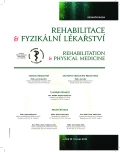Possibilities of Hippotherapy for Child Patients with Cerebral Palsy
Authors:
K. Čapková 1; D. Pavlů 2
Authors‘ workplace:
Centrum hiporehabilitace Mirákl, o. p. s., Kralupy nad Vltavou
1; Katedra fyzioterapie UK FTVS, Praha
vedoucí katedry doc. PaedDr. D. Pavlů, CSc.
2
Published in:
Rehabil. fyz. Lék., 23, 2016, No. 2, pp. 114-118.
Category:
Original Papers
Overview
In the following presentation, we will show different possibilities of using hippotherapy for treating children with cerebral palsy. The main emphasis is laid on a unified methodological approach, which has been created based on many years of practical experience, including verification of effectiveness during active practice combined with the use of therapeutic approaches from around the world. The presented approach has also been created due to the absence of a comprehensive education in the hippotherapy field and also for the purpose of creating a standardized approach among today's many highly variable ones. The methodology is strictly separated into two principles of horseback functionality, that of rimotor stimulation and differentiation. It operates with variable and non-variable factors, which ensures the treatment of one of the principles according to the needs of the client. These presented approaches expand the possibilities of physiotherapeutic approaches for the treatment of cerebral palsy and offers wider possibilities for complex treatment of these children.
Keywords:
hippotherapy, cerebral palsy, physiotherapy, rimotor stimulation, differentiation
Sources
1. BIEWALD, F.: Das Bobath-koncept. 2.vyd., Munchen: Elsevier, 2004. ISBN: 40-398-3789-1.
2. ČÁPOVÁ, J.: Terapeutický koncept „Bazální programy a podprogramy“. 1. vyd., Praha, Repronis, 2008, ISBN 978-80-7329-180-8.
3. ČAPKOVÁ, K.: Vliv plemene koně a tempa jeho kroku na timing svalů v hipoterapii. Diplomová práce, 2010, FTVS UK.
4. DVOŘÁKOVÁ, T., PAVELKOVÁ, J. et al.: Analýza pohybu v hipoterapii z pohledu biomechaniky. Rehabilitace a fyzikální lékařství, roč. 12, 2005, s. 123-126.
5. DVOŘÁKOVÁ, T.: Využití biomechaniky při analýze pohybu koně. In DVOŘÁKOVÁ, T. (Eds.), Mezinárodní konference Aktuální otázky chovu koní v ČR. Ed. T. Dvořáková. Brno, MZLU v Brně, 2004, s. 140-145.
6. HORNÁČEK, K., HOLLÝ, K.: Hipoterapie – léčba pomocí koně. 2. vyd. Praha, Montanex, 2002, ISBN 80-7225-190-2.
7. CHAMPAGNE, L.: CanTRA and hippotherapy. [online]., Kanada, 2008. [c 2011-1-13]. Dostupné z: [http://www.cantra.ca/hippotherapy.shtml].
8. JANURA, M.: Úvod do biomechaniky pohybového chování. 1. vyd., Olomouc, Univerzita Palackého v Olomouci, 2008, ISBN: 978-80-244-0644-2.
9. JISKROVÁ, I., CASKOVÁ, V. et al.: Hiporehabilitace. 1. vyd.,Brno, Mendelova univerzita v Brně, 2010, ISBN 978-80-7375-390-0.
10. KULICHOVÁ, J. a kol. autorů.: Hiporehabiliatce. 1. vyd., Praha, Nadace OF, 1995.
11. KRAČMAR, B., VYSTRČILOVÁ, M. et al.: Ramenní pletenec v režimu kvadrupedální lokomoce. Rehabilitace a fyzikální lékařství, roč. 2, 2005, s. 92-98.
12. KRAUS, J.: Dětská mozková obrna. 1. vyd., Praha, Grada, 2005, ISBN 80-247-1018-8.
13. KŘENKOVÁ, D.: GMFM. Metodika bodového hodnocení cviků. 2. vyd., 1993.
14. Mezinárodní klasifikace nemocí. Desátá revize. Tabelární část. Staženo dne 5. 1. 2014. Dostupné z [http://www.uzis.cz/cz/mkn/index.html].
15. MOORE, T.: What RDA does. [online]. Austria: 2010. [c 2010-11-15]. Dostupné na: [www.rda.org.au/what-we-do.aspx].
16. NICHOLSON, N.: Biomechanical riding and dressage. 2. vyd., Human Kinetice, 2008.
17. SOUČKOVÁ, K.: Komunikační schémata v hiporehabilitaci. Bakalářská práce, 2010. Univerzita Jana Ámose Komenského.
18. STRUMINSKA, A.: A horseback tour – An encounter with nature and art. In STRUMINSKA, M. (Eds.), XII International congress of therapeutic riding. Ed. A. Struminska. Brasil.-Fhul, 2006, s. 186-190.
19. ŤUPOVÁ, K., KROBOT, A.: Hipoterapie jako doplňková metoda fyzioterapie: rešerže dostupné literatury. Rehabilitace a fyzikální lékařství, roč. 19, 2012, s. 74-79.
20. VÉLE, F.: Kineziologie pro klinickou praxi. 2. vyd., Praha, Triton, 2006, ISBN 80-2754-837-9.
21. WHITBY, L. NZRDA: Edication programms. [online]. New Zeland, 2006. [c 2010-11-15]. Dostupné z: [www.rda.org.nz/about/].
Labels
Physiotherapist, university degree Rehabilitation Sports medicineArticle was published in
Rehabilitation & Physical Medicine

2016 Issue 2
- Hope Awakens with Early Diagnosis of Parkinson's Disease Based on Skin Odor
- Deep stimulation of the globus pallidus improved clinical symptoms in a patient with refractory parkinsonism and genetic mutation
Most read in this issue
- Sacralization of Vertebra L5
- Positioning Chronically Immobile and Terminally-Ill Patients
- Options of Physiotherapy for Patients with Kidney Disease, on Dialysis and after Kidney Transplantation - Overview from Past to Present
- Spectrum, Trends and Approaches in Contemporary Neurorehabilitation
